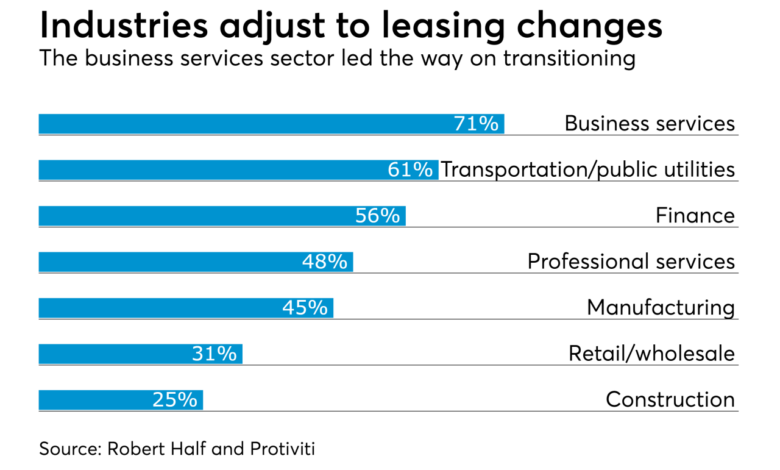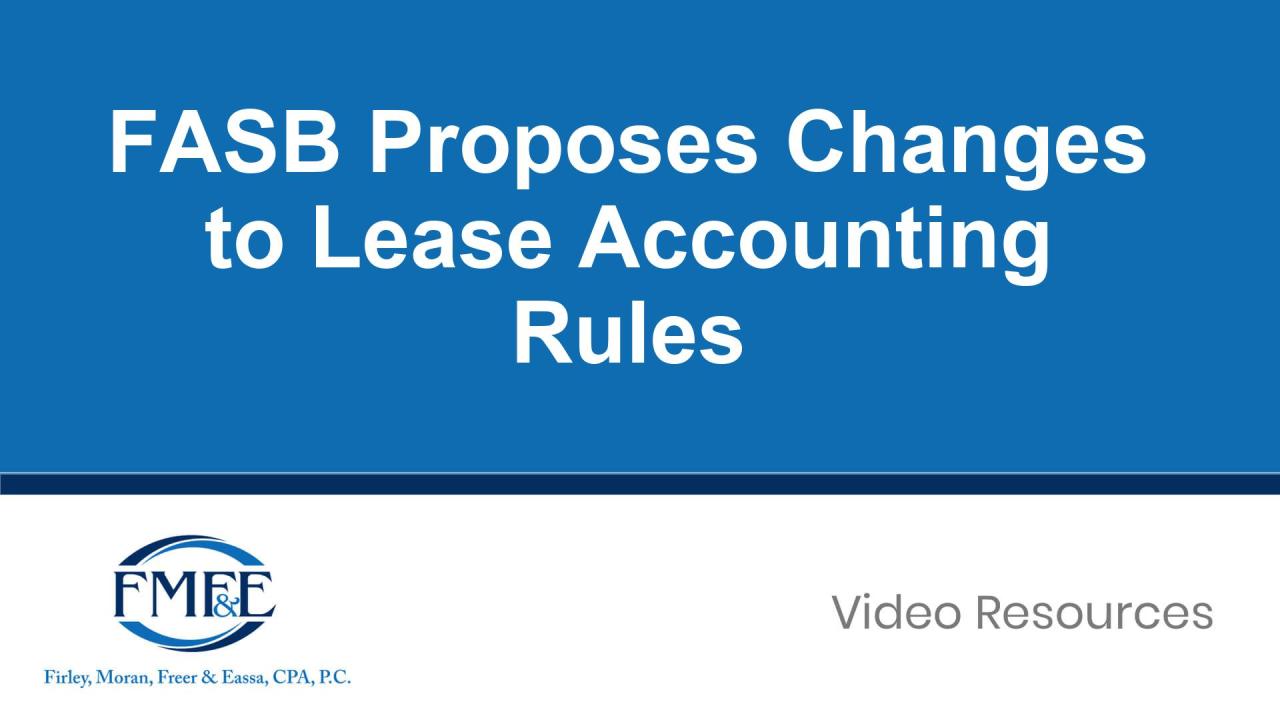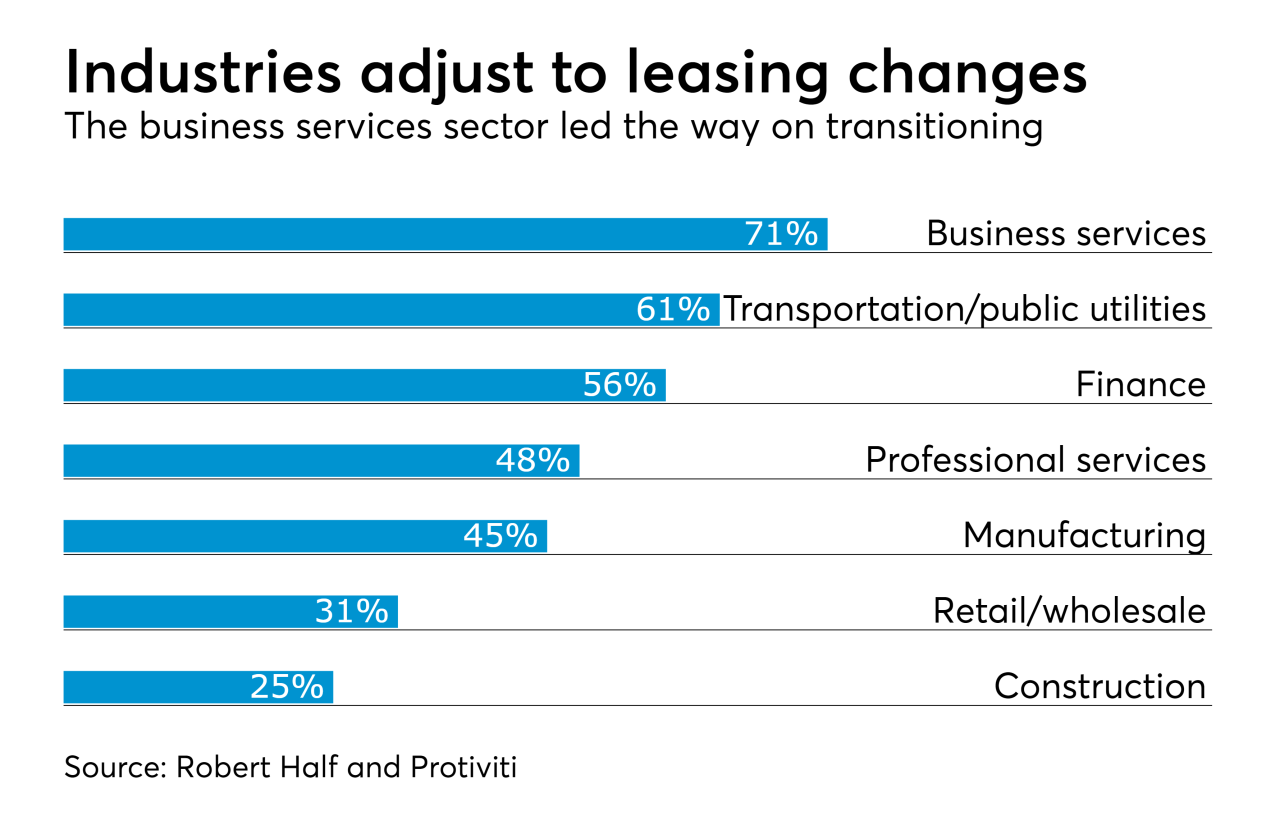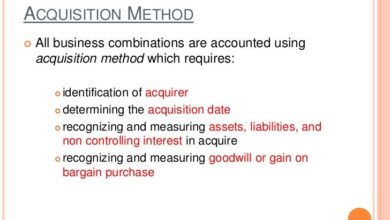
FASB Lease Accounting Standard A Comprehensive Guide
FASB lease accounting standard is revolutionizing how companies report leases. This new standard brings significant changes to financial reporting, impacting balance sheets, income statements, and cash flow statements. Understanding these changes is crucial for investors, analysts, and businesses alike. This guide dives deep into the intricacies of the new standard, from its historical context to practical applications and future trends.
The old standard, often criticized for its complexities, is now superseded by a new, more transparent approach. This new framework aims to provide a more accurate picture of a company’s financial position and obligations related to leases.
Introduction to FASB Lease Accounting Standard
The Financial Accounting Standards Board (FASB) lease accounting standard, a significant change in financial reporting, significantly altered how companies account for leases. This new standard, impacting both lessees and lessors, aims to provide a more transparent and comparable view of a company’s lease obligations on their balance sheets. Understanding the intricacies of this change is crucial for investors, analysts, and company management alike.The old lease accounting standards primarily focused on operating leases, which were not recorded on the balance sheet.
This meant that companies could effectively hide significant financial obligations. The new standard, however, mandates the recognition of most leases on the balance sheet as either finance or operating leases. This shift dramatically alters how companies present their liabilities and assets, impacting their financial ratios and overall financial picture.
Key Differences Between Old and New Standards
The old standard, primarily based on the distinction between operating and capital leases, lacked consistency and transparency. Operating leases were not reflected on the balance sheet, leading to an underestimation of a company’s liabilities. The new standard addresses this by requiring most leases to be recognized on the balance sheet. This improves the reliability of financial statements, providing a more accurate representation of a company’s financial position and performance.
Historical Context of the Standard’s Development
The development of the new lease accounting standard stemmed from a growing need for improved financial reporting. Companies’ lease obligations were often hidden from investors, leading to inaccurate assessments of their financial health. The need for increased transparency and comparability drove the FASB to create a new standard. This change reflects a broader trend in accounting standards toward increased transparency and comparability, aimed at providing investors and stakeholders with more reliable and comprehensive information.
Key Changes in the Standard
| Feature | Old Standard | New Standard |
|---|---|---|
| Lease Recognition | Operating leases off-balance sheet; capital leases on-balance sheet | Most leases recognized on balance sheet as either finance or operating leases |
| Lease Classification | Based on economic substance (e.g., term, transfer of ownership) | Based on the criteria of control of the asset |
| Measurement of Lease Liabilities | No measurement of lease liability for operating leases | Present value of lease payments over the lease term |
| Disclosure Requirements | Limited disclosure requirements for operating leases | Comprehensive disclosure requirements for both finance and operating leases |
The table above highlights the significant changes in the accounting treatment of leases. The new standard significantly increases the transparency and comparability of financial statements. This enhances the reliability of information for investors and stakeholders, promoting better decision-making.
Types of Leases
The new lease accounting standard significantly impacts how companies report lease transactions. Understanding the different types of leases is crucial for accurate financial reporting and analysis. This standard, requiring lessees to recognize all leases on their balance sheets, necessitates a clear comprehension of the distinctions between operating and finance leases.The standard classifies leases into two primary categories: operating leases and finance leases.
This categorization fundamentally affects how companies recognize and report lease obligations and assets on their financial statements. The classification depends on the economic substance of the lease agreement, not merely its legal form.
Lease Classification Criteria
The crucial distinction between operating and finance leases lies in the transfer of risks and rewards associated with ownership. The criteria for classifying leases are Artikeld in the accounting standard and are designed to accurately reflect the economic reality of the lease arrangement. These criteria are not just arbitrary rules; they are designed to ensure consistency and comparability in financial reporting across different companies and industries.
Operating Leases
Operating leases are characterized by the lessee not substantially transferring risks and rewards inherent to ownership. In essence, the lessee essentially rents the asset, and the lessor retains most of the risks and rewards of ownership. The lessee recognizes lease payments as an expense over the lease term. A key aspect of operating leases is that they don’t result in the lessee acquiring ownership or control of the underlying asset.
For example, a company leasing office space typically enters into an operating lease, recognizing lease payments as an expense over the lease term.
Finance Leases
Finance leases, conversely, transfer substantially all the risks and rewards inherent in ownership to the lessee. This signifies a significant transfer of ownership-like rights and obligations. The lessee recognizes a right-of-use asset and a lease liability on the balance sheet. The lease liability represents the present value of the lease payments over the lease term. For instance, a company leasing a significant piece of equipment that significantly meets the criteria for a finance lease would record it as such.
Comparison of Operating and Finance Leases
| Lease Feature | Operating Lease | Finance Lease ||—|—|—|| Transfer of Ownership | No significant transfer | Substantial transfer || Risks and Rewards | Lessor retains majority of risks and rewards | Lessee assumes majority of risks and rewards || Recognition on Balance Sheet | Lease payments as expense | Right-of-use asset and lease liability || Lease Term | Usually shorter | Often coincides with the useful life of the asset || Present Value of Lease Payments | Not recognized as a liability | Recognized as a lease liability || Bargain Purchase Option | Typically absent | Often present || Asset’s Useful Life | Lease term is shorter than the asset’s useful life | Lease term is approximately equal to the asset’s useful life || Initial Measurement of Lease Liability | No initial measurement of lease liability | Initial measurement of lease liability |
Accounting for Leases

The new lease accounting standard significantly impacts financial reporting, requiring companies to recognize assets and liabilities for leases previously treated as operating leases. This shift from an operating to a balance sheet approach provides a more comprehensive picture of a company’s obligations and resources tied to leased assets. Understanding the accounting treatment is crucial for accurate financial statement presentation and analysis.
Accounting Treatment for Operating Leases
Operating leases, in contrast to finance leases, do not transfer substantial risks and rewards of ownership to the lessee. The lessee continues to use the asset without taking on significant ownership characteristics. Under the new standard, operating leases are accounted for by recognizing lease payments as an expense over the lease term, reflecting the consumption of the right to use the asset.
Accounting Treatment for Finance Leases
Finance leases, on the other hand, transfer substantially all the risks and rewards of ownership to the lessee. This results in the recognition of a lease liability and a right-of-use (ROU) asset on the lessee’s balance sheet. The lease liability reflects the lessee’s obligation to make lease payments, while the ROU asset represents the right to use the leased asset.
Journal Entries for Operating Leases
The journal entries for operating leases are straightforward, focusing on recognizing lease payments as an expense over the lease term. For example, if a company incurs a monthly lease payment of $1,000, the journal entry for the first month would be:
- Debit: Lease Expense – $1,000
- Credit: Cash – $1,000
This entry reflects the outflow of cash and the corresponding recognition of the lease expense.
Journal Entries for Finance Leases
Finance leases require more complex journal entries, involving the recognition of both a lease liability and a right-of-use asset. For instance, consider a lease with a term of 5 years and annual payments of $10,
000. The initial journal entry would include
- Debit: Right-of-Use Asset – $45,000 (calculated using present value techniques)
- Credit: Lease Liability – $45,000 (calculated using present value techniques)
Subsequent journal entries would record lease payments, adjusting both the lease liability and interest expense.
Calculating Lease Liability and Right-of-Use Asset
The lease liability and right-of-use asset are calculated using present value techniques. The present value of future lease payments, discounted at an appropriate interest rate, determines the lease liability. The right-of-use asset is initially recognized at the same amount as the lease liability. For example, if a company leases equipment with future payments of $10,000 annually for five years, discounted at a 5% interest rate, the present value of the lease payments would be used to determine the lease liability and right-of-use asset.
Step-by-Step Procedure for Recording Lease Transactions
A structured approach to recording lease transactions is vital for accurate financial reporting. The procedure involves several steps:
- Identify the lease type (operating or finance). This determination is critical, as it dictates the accounting treatment.
- Determine the lease term. The lease term is the period over which the lessee has the right to use the asset.
- Calculate the lease liability and right-of-use asset. This calculation uses present value techniques and the appropriate interest rate.
- Record the initial journal entry. This entry recognizes the lease liability and the right-of-use asset.
- Record subsequent lease payments. These payments are allocated between interest expense and reduction of the lease liability.
Following these steps ensures compliance with the new lease accounting standard and provides a clear path for recording lease transactions.
Impact on Financial Statements: Fasb Lease Accounting Standard
The new lease accounting standard significantly alters how companies report their financial performance and position. This shift from an operating lease to a financing lease model impacts various financial statements, potentially reshaping investor perceptions and company valuations. Understanding these effects is crucial for both investors and corporate decision-makers.
Balance Sheet Impacts
The most immediate impact of the new standard is on the balance sheet. Previously, operating leases were not recorded as assets or liabilities. Now, all leases with terms of a year or more must be recognized as right-of-use assets and lease liabilities on the balance sheet. This results in a larger reported asset base and a corresponding increase in liabilities.
For example, a company leasing significant equipment will see an increase in both assets and liabilities.
Income Statement Impacts
The income statement reflects the lease expense over the lease term. Instead of a single, uniform expense, the expense is broken down into interest expense and depreciation. This often leads to a more predictable and consistent pattern of lease expense recognition over time, though the overall expense can vary depending on the lease terms. This detailed expense recognition allows for a clearer picture of the company’s operating costs.
Cash Flow Statement Impacts, Fasb lease accounting standard
The cash flow statement is also affected, with lease payments now categorized into financing activities (representing the repayment of the lease liability) rather than operating activities. This change can affect the overall cash flow profile of the company, and it will impact the assessment of the company’s ability to generate cash.
Key Financial Metrics Affected
Several key financial metrics are affected by the new lease accounting standard. Debt-to-equity ratios, for instance, will likely change as lease liabilities are added to the balance sheet. Similarly, the calculation of free cash flow will be modified, since lease payments will now be included in financing activities. EBITDA (Earnings Before Interest, Taxes, Depreciation, and Amortization) is also impacted.
Impact on EBITDA
EBITDA = Revenue – Operating Expenses – Depreciation – Amortization
The new lease accounting standard affects EBITDA by adding lease expense. This new expense will be broken down into interest and depreciation components. Therefore, a company’s reported EBITDA will likely decrease, potentially reducing investor confidence.To illustrate, consider a company with $100,000 in annual lease payments. Under the old standard, this was not reflected in EBITDA. Under the new standard, the interest and depreciation components of the lease payment will be added to operating expenses, leading to a reduction in EBITDA.
Potential Effects on Company Valuations and Investor Perceptions
The changes in reported financials can influence investor perceptions. Companies with substantial lease obligations may see their valuations adjusted downward as investors assess the long-term financial implications. Investors will need to consider the new lease expense and lease liabilities when evaluating a company’s financial health and future prospects.
Practical Application and Examples
The FASB lease accounting standard, a significant shift from prior accounting practices, necessitates a profound understanding of lease classifications and their implications for financial reporting. This section delves into practical applications, providing real-world examples and case studies to illustrate the standard’s impact across various industries. It also explores common challenges and the evaluation of financial health implications.Applying the standard effectively requires meticulous analysis of lease agreements and a clear understanding of the underlying economic substance.
This often involves detailed examination of lease terms, options, and residual values to accurately classify leases as either finance or operating.
Real-World Examples in Different Industries
The new lease accounting standard impacts a wide range of industries. Retailers, for instance, may lease significant amounts of retail space. Correctly accounting for these leases is crucial for accurate reporting of assets and liabilities. Similarly, manufacturing companies, often leasing equipment for production, will see a significant change in balance sheet presentation. Transportation companies, using trucks and trailers under lease, must also adapt to the new reporting requirements.
Case Study: A Retail Store Lease
Consider a retail store leasing space for 5 years. The lease agreement includes an option to purchase the property at a pre-determined price at the end of the lease term. This option, coupled with the lease term, makes it likely that the lease is classified as a finance lease. The store will recognize a right-of-use asset and a lease liability on its balance sheet, reflecting the present value of future lease payments.
The store’s balance sheet will show a larger asset and liability than previously.
Common Implementation Challenges
Accurate implementation of the new standard can present several challenges. One significant hurdle is the complexity of lease agreements themselves. Sometimes, the terms are intricate, involving numerous options and contingent events. Properly interpreting these agreements and correctly classifying the lease can be demanding. Another difficulty is estimating the useful life of the leased asset and the appropriate discount rate for determining the lease liability.
Accurate estimation of these factors can be challenging.
Evaluating Impact on Financial Health
The standard’s impact on a company’s financial health can be multifaceted. The key is not just the numbers on the balance sheet, but the implications for financial ratios and the overall financial profile. For instance, a company with many finance leases might experience a higher debt-to-equity ratio, which could affect its ability to secure further financing. Conversely, a company with many operating leases might see a reduced impact on its balance sheet, but the ongoing expense is still a critical factor to consider.
The impact on profitability, free cash flow, and other key metrics should be analyzed alongside the balance sheet impact. A comprehensive evaluation is essential.
Transitioning to the New Standard

The adoption of the new lease accounting standard requires significant changes for companies. Understanding the transition process, disclosures, and financial reporting impacts is crucial for a smooth implementation. This section details the key aspects of transitioning to the new lease accounting standard, including methods to ensure a smooth process.
Transition Method
The transition to the new lease accounting standard is a significant undertaking, and the method selected will affect the financial reporting of the company. Companies can choose either a retrospective approach or a prospective approach for applying the new standard to prior periods. The retrospective approach requires adjusting prior periods’ financial statements to reflect the new lease accounting rules.
This method provides a more accurate picture of a company’s financial position and performance, but it can be more complex to implement. The prospective approach, on the other hand, only applies the new standard to periods beginning after the adoption date. This approach is often chosen when the retrospective approach presents considerable difficulties.
Required Disclosures
Comprehensive disclosures are essential for transparency and allow stakeholders to understand the impact of the new standard on the company’s financial position and performance. The disclosures must include information on lease arrangements, including the lease term, lease payments, and any contingent rentals. Furthermore, companies must disclose the impact of the transition on their financial statements, such as changes in assets, liabilities, and income.
This includes the carrying amount of right-of-use assets and lease liabilities.
Impact on Financial Reporting
The transition to the new lease accounting standard will significantly affect a company’s financial statements. The recognition of lease liabilities will increase the company’s total liabilities. This, in turn, will affect key financial ratios, such as the debt-to-equity ratio. The recognition of right-of-use assets will increase the company’s total assets. This is a significant change that needs to be carefully considered.
The impact on financial reporting should be analyzed to understand its implications for various stakeholders, including investors, creditors, and analysts.
Methods for a Smooth Transition
Implementing a smooth transition to the new lease accounting standard requires careful planning and execution. Companies should establish a dedicated project team to oversee the transition process. This team should be equipped with the necessary expertise to handle the complexities of the new standard. They must develop a detailed implementation plan, which includes timelines, responsibilities, and resources. This plan should also incorporate procedures to ensure data accuracy and consistency throughout the process.
- Data Collection and Validation: Thoroughly collect all lease data from various sources, ensuring accuracy and consistency. Validate the data to identify and correct any discrepancies. This step is critical to ensure the new standard’s accurate application.
- Software Systems Update: Companies should update their accounting software to accommodate the new lease accounting standard. This includes modifying existing systems or implementing new ones. This ensures data is accurately recorded and reported according to the new standard.
- Training and Communication: Provide adequate training to personnel involved in the transition process. This ensures everyone understands the new standard’s implications and how to apply it correctly. Communicate the changes to all stakeholders, including investors and creditors, to maintain transparency.
Comparison with IFRS Lease Accounting
The FASB and IFRS lease accounting standards, while both aiming to improve financial reporting transparency, differ in their approaches. Understanding these differences is crucial for multinational companies navigating the complexities of global reporting. This comparison highlights the key similarities and divergences, and discusses the implications for international operations.The fundamental shift towards recognizing leases on the balance sheet, driven by both standards, is designed to provide a more accurate reflection of a company’s liabilities and assets.
However, the specific implementation details and recognition criteria vary, creating potential accounting inconsistencies between companies following different standards.
Key Similarities
Both standards require lessees to recognize leases on the balance sheet, moving away from the previous operating lease treatment. This fundamental shift aims to provide a more complete and transparent view of a company’s obligations. Both standards also recognize leases based on the economic substance of the arrangement. This recognition of the lease’s economic substance, rather than just the legal form, is a key similarity and aims to present a truer picture of the lease’s economic impact.
Key Differences
Significant differences exist in how lease terms are classified and measured. The FASB standard primarily uses a dual classification (finance or operating) based on a five-criteria test, while IFRS employs a single classification method. This difference affects the recognition and measurement of lease assets and liabilities.The FASB standard, unlike IFRS, does not include a specific exemption for short-term leases.
This can lead to significant differences in the number of leases recognized on the balance sheet. IFRS, on the other hand, includes a short-term lease exemption, simplifying accounting for certain lease arrangements. This exemption often means that short-term leases, while still having economic substance, are not recognized on the balance sheet under IFRS.
Implications for Multinational Companies
Multinational companies face a critical challenge in maintaining consistent financial reporting when operating under different accounting standards. Differences in lease classification and recognition criteria can lead to discrepancies in financial statements, potentially impacting comparability and analysis. To address this, companies often use consistent accounting policies across their operations, or make necessary adjustments to ensure comparability when reporting to different stakeholders.
Comparison Table
| Feature | FASB Standard | IFRS Standard |
|---|---|---|
| Lease Classification | Dual classification (finance or operating) based on a five-criteria test | Single classification method |
| Short-Term Leases | No specific exemption | Specific exemption for short-term leases |
| Lease Measurement | Generally based on the present value of lease payments | Generally based on the present value of lease payments |
| Variable Lease Payments | Includes specific guidance on accounting for variable lease payments | Includes specific guidance on accounting for variable lease payments |
Recent Developments and Future Trends
The FASB’s lease accounting standard has significantly impacted businesses worldwide, forcing a re-evaluation of how they report and manage lease obligations. Understanding the ongoing evolution of this standard is crucial for maintaining financial reporting accuracy and strategic planning.The accounting treatment of leases has undergone substantial changes over time. Early accounting standards often treated leases as operating expenses, leading to a lack of transparency in financial reporting.
The new standard, issued in 2016, brought significant changes by requiring the recognition of most leases on the balance sheet. This change necessitates a thorough understanding of the new accounting principles and their application across various business contexts.
Recent Updates and Amendments
The FASB has, so far, not issued significant amendments to the lease accounting standard. However, the ongoing evolution of accounting standards in the broader context is crucial to consider. While there have been no major revisions to the core principle of recognizing leases on the balance sheet, future updates might address specific complexities or emerging issues in lease agreements.
The standard, while comprehensive, might not always perfectly capture every nuanced situation.
Potential Future Changes and Enhancements
The accounting landscape is constantly evolving, and future changes to the standard are likely. Amendments may focus on areas such as:
- Clarification of specific lease types, such as variable lease payments or leases with purchase options. These often present complexities in practical application.
- Improved guidance on the accounting treatment of lease modifications. A lease modification can significantly alter the financial obligations and reporting.
- Addressing the unique accounting considerations for entities with a large portfolio of leases, especially in industries such as real estate or transportation. These entities often require specific guidance to manage the complex reporting.
Potential Implications for the Business Environment
The potential changes in the lease accounting standard could affect businesses in various ways. For instance, the need to accurately reflect lease obligations on the balance sheet can impact creditworthiness and capital budgeting decisions. Changes in the accounting treatment of lease modifications could require businesses to reassess their lease portfolio management strategies. Moreover, enhanced guidance on variable lease payments might prompt businesses to carefully review the terms of their existing leases.
History of the FASB’s Lease Accounting Standard
The FASB’s lease accounting standard journey has been a gradual process of refinement and adaptation. The evolution of the standard can be summarized as follows:
- Initially, leases were often treated as operating expenses, leading to an incomplete representation of a company’s financial position.
- The 2016 standard fundamentally changed the way leases are recognized, bringing greater transparency to financial reporting.
- Subsequent developments in the standard have focused on providing clarity and practical guidance on various aspects of lease accounting, including modifications and variable payments.
Closing Notes
In conclusion, the FASB lease accounting standard represents a significant shift in how companies account for leases. Navigating the new rules and understanding their implications for financial reporting is critical for stakeholders. This guide has provided a comprehensive overview of the standard, its impact, and the practical steps involved in transitioning to the new framework. While challenges exist, the standard ultimately enhances transparency and allows for a more accurate assessment of a company’s financial health.
FAQ Resource
What are the key differences between operating and finance leases under the new standard?
The new standard requires companies to classify leases as either operating or finance leases based on specific criteria. Key differences include the recognition of a lease liability and right-of-use asset for finance leases, which wasn’t required under the old standard. Operating leases continue to be treated differently, with no recognition of a lease liability or right-of-use asset.
How does the new standard impact the calculation of EBITDA?
The impact on EBITDA varies depending on the type of lease. For finance leases, interest expense and depreciation will be included in the calculation, potentially reducing EBITDA compared to the old standard. For operating leases, the impact is typically less significant.
What are the transition options for companies adopting the new standard?
Companies have options for transitioning to the new standard. They can either apply the standard retrospectively to all leases from the effective date or prospectively, applying it to new leases only. The chosen method will affect the financial statements for the period of transition.
What are some common challenges in implementing the new standard?
Companies may face challenges in identifying and classifying all lease agreements, particularly those with complex terms. Accurately determining the lease term and discount rate can also be challenging, leading to potential errors in calculating lease liability and right-of-use asset.





